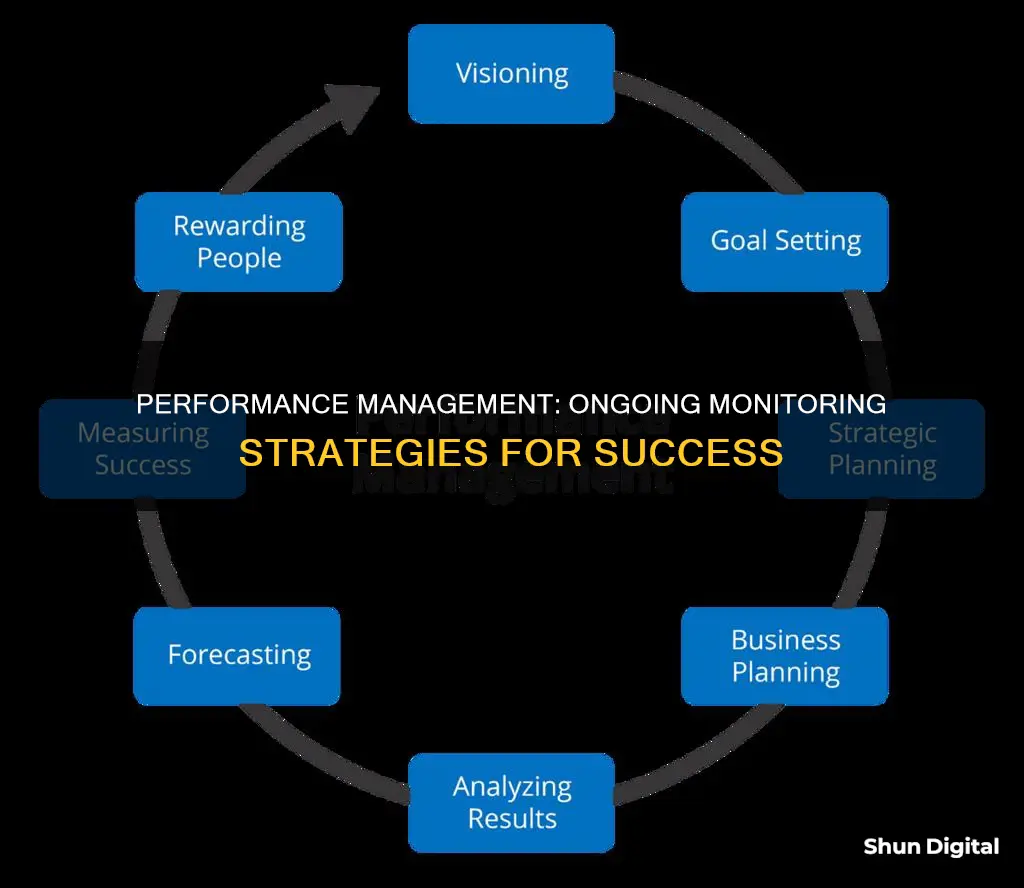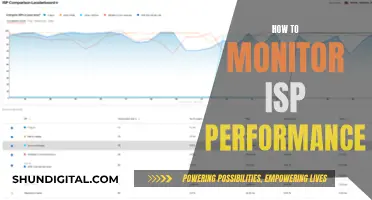
Performance management is a critical aspect of employee development and retention. It involves measuring and evaluating employee performance, providing feedback, and identifying growth opportunities. To effectively monitor employee performance, managers can employ various strategies such as regular one-on-one meetings, direct observation, performance management software, task management software, and self-monitoring tools. Additionally, tracking key performance indicators (KPIs) and conducting periodic reviews are essential for assessing progress and making necessary adjustments. Performance monitoring helps organisations improve productivity, employee satisfaction, and overall success.
What You'll Learn

Set clear expectations and goals
Setting clear expectations and goals is the first step in performance management. It involves defining each team member's roles and responsibilities, the goals they are expected to achieve, the key performance indicators (KPIs) that will be used to measure their progress, and the expected standards of behaviour.
When setting clear expectations, it is important to consider the following:
Roles and Responsibilities
Confusion about roles and responsibilities can arise when starting a new job, transferring roles, having a new supervisor, or following structural changes. To avoid this, each team member should have a clear understanding of their scope of responsibility, including:
- Areas of responsibility: What are the key areas in which the team member is expected to deliver results? (e.g. customer service, staff training, administration)
- Tasks: What are the specific tasks within each area that they are responsible for? (e.g. answering phones, setting up client accounts)
- Autonomy/authority: What level of autonomy does the team member have in completing tasks? Do they need to consult with others, or can they make decisions independently?
Goals and KPIs
Goals and KPIs tell team members what they are striving to achieve and how their progress will be measured. If your team members don't have goals or KPIs, consider putting some in place. Goals should be SMART (specific, measurable, achievable, relevant, and time-bound).
Standards of Behaviour
In addition to performance expectations, it is crucial to set expected standards of behaviour. These standards should align with the organisation's values, code of conduct, and team ground rules. Organisational values should be communicated and reinforced regularly, and team members should understand the consequences of breaching the code of conduct. Team ground rules, such as being respectful in communication or punctual for meetings, set a baseline for effective teamwork behaviours.
Communication
Maintaining a strong system of communication is essential for setting clear goals and expectations. Transparent, respectful, and timely communication promotes trust and provides clarity for employees, fostering a culture of improvement. Leaders should be skilled at receiving and responding to communications from employees, creating an approachable and accessible environment.
Feedback
Establishing a system of feedback increases employee motivation and provides the necessary clarity on goals and expectations. Regular feedback from supervisors and peers empowers employees and encourages them to provide meaningful feedback to the team and leadership. This creates a high-performance environment where employees are motivated to achieve creative and innovative solutions.
Esports Racing: Monitor Size for the Ultimate F1 Experience
You may want to see also

Monitor employee progress and provide feedback
Monitoring employee progress and providing feedback is a critical aspect of performance management. It involves tracking the quality, quantity, and efficiency of employees' work and providing ongoing feedback to drive their development. Here are some detailed strategies to effectively monitor employee progress and provide meaningful feedback:
Regular One-on-One Meetings:
Establishing a routine of regular, ongoing, one-on-one meetings is essential for monitoring employee progress. During these meetings, ask employees for an account of their actions since the last meeting, probe further with relevant questions, and discuss next steps. This practice holds employees accountable and provides an opportunity to offer feedback and guidance.
Direct Observation:
Visual monitoring of employees in the workplace can provide valuable insights into their performance. Make it a habit to move around the workplace throughout the day to gauge employees' attitudes and spot potential issues. Regularly shadow employees for extended periods to identify any inefficient habits or skill gaps. Direct observation is especially effective when done discreetly and on a surprise basis.
Self-Monitoring Tools:
Encourage employees to use self-monitoring tools such as project plans, checklists, and activity logs. These tools enable employees to track their progress toward goals and deadlines. Activity logs, in particular, provide a detailed record of employees' daily activities, including breaks and interruptions, offering valuable insights for performance evaluation.
Spot-Checking Progress:
For long-term projects, set clear goals, expectations, and milestones, and communicate that you will be spot-checking progress regularly. This can be done through stand-up meetings, direct observation of tangible progress, reviewing drafts or current versions of deliverables, etc. Spot-checking keeps you informed about the work being done and allows for timely problem-solving.
Performance Management Software:
Utilize performance management software to track and evaluate employee performance. These tools can help identify areas of improvement and recognize employees' accomplishments, no matter how small. Regular feedback is essential for employee engagement and development.
360-Degree Reviews:
Conduct 360-degree reviews where employees receive feedback from superiors and peers. This process provides a well-rounded perspective on employees' performance and is especially useful for high-performing individuals who may not receive frequent feedback.
Employee Self-Evaluations:
Encourage employees to engage in self-evaluation by reflecting on their performance against objective standards. This can be done through surveys, questionnaires, or graded assessments. Self-evaluation promotes self-awareness and ownership of their development.
Regular Performance Appraisals:
Conduct timely and consistent performance appraisals to ensure employees receive appropriate recognition and compensation for their efforts. Regular appraisals also keep goals at the forefront, aligning daily tasks with long-term objectives.
Feedback from Stakeholders:
Gather intelligence by asking customers, vendors, coworkers, and other managers about their interactions with specific employees. Seek specific details about employees' work rather than personal impressions or evaluations. This approach provides valuable insights from diverse perspectives.
By implementing these strategies, managers can effectively monitor employee progress, provide meaningful feedback, and drive performance improvement, ultimately contributing to the success of both the employees and the organization.
Identifying HDR Monitors: What You Need to Know
You may want to see also

Utilise performance management software
Performance management software is an important tool for any organisation that wishes to streamline its employee management process. When selecting a software, HR leaders should ensure it includes certain key features and functionalities to make it a worthwhile investment.
Firstly, the software should offer simple navigation with an intuitive and appealing user interface. If the software is too complex, users may avoid it altogether. The goal-setting feature should be straightforward and easy to understand, with simple navigation that doesn't require users to click through multiple pages.
Secondly, the software should provide ongoing employee performance tracking capabilities. This includes capturing data from regular check-ins and formal performance discussions, which can then be used to inform an employee's goals or for managers to give general feedback. Employees should also be able to record their thoughts about their performance and identify potential growth opportunities. Recognition received from peers or leadership should also be easily accessible within the software.
Thirdly, the software should offer a 360-degree feedback option, allowing for a more comprehensive view of an employee's performance. This can include feedback requests from leaders to other leaders or employees requesting feedback from their peers.
Additionally, the software should have responsive and reliable customer service. As issues may arise, it is important that vendors offer timely and effective support. This could include 24/7 support, support in the required languages, a dedicated support representative, and self-service tools such as FAQs, training materials, and a customer community.
Real-time data reporting and analysis are also essential features. The software should provide updated information through reports and dashboards, allowing administrators and power users to quickly access the information they need. For example, during a performance review process, it should be easy to see the number of completed reviews and who has completed them.
Mobile support is another critical feature, as it allows managers and employees to access the software remotely. An app or a responsive web design that adjusts the layout based on the device is ideal.
Furthermore, the frequency of system updates should be considered. While vendors may not commit to fixing issues before a release, knowing the schedule of minor and major upgrades can provide reassurance. Major upgrades also introduce new features and resolve old defects, so understanding the vendor's release schedule can be beneficial when new functionality is required.
Customisation abilities are also important. The software should allow administrators to customise or configure the system to align with the organisation's performance appraisal process. This includes selecting performance modules, renaming terminologies, choosing evaluators, rating types, and review periods.
Finally, integration with other software is key. The performance management software should be able to integrate with other systems to access relevant data, such as completed courses and sales performance, which may impact an employee's performance review. This data should be available in real time.
Monitor Color Accuracy: How to Spot Issues
You may want to see also

Conduct regular one-on-one meetings
Section title: Conduct regular one-on-one meetings
One-on-one meetings are a powerful tool for managers to engage and retain their team members. They are a dedicated time for managers and employees to connect, address concerns, and build trust. To make the most of these meetings, it is important to establish clear goals, create a safe and open environment, and ensure effective communication and feedback. Here are some guidelines to conduct productive one-on-one meetings:
Frequency and Duration
The frequency and duration of one-on-one meetings may vary depending on the relationship between the manager and the employee. However, it is recommended to have weekly meetings lasting around 30 minutes. For new relationships, it is better to overbook and adjust as needed. If there are many topics to discuss, consider weekly meetings, while for less frequent topics, a monthly cadence may be more suitable.
Purpose and Benefits
The primary purpose of one-on-one meetings is to build a strong working relationship between managers and their team members. These meetings provide a platform for open communication, feedback, and discussion of growth, performance, development, and motivation. One-on-ones are also valuable for addressing common workplace challenges, improving employee engagement and motivation, and creating a psychologically safe environment.
Preparation and Structure
To ensure productive one-on-one meetings, both managers and employees should come prepared.section title:
For managers:
- Create a safe and open environment by being vulnerable and sharing personal stories or fears.
- Be transparent and share relevant information, even if it is uncomfortable.
- Set clear expectations for the meeting, such as punctuality, preparation, and active participation.
- Listen actively and ask open-ended questions to encourage dialogue.
- Take notes during the meeting to document discussions, decisions, and action items.
For employees:
- Drive the conversation by preparing an agenda and sending it to the manager in advance. This ensures that important topics are covered.
- Set clear expectations for the meeting and hold yourself and the manager accountable.
- Provide ample time for the manager to prepare by sending the agenda at least one day before the meeting.
Topics to Discuss
The topics discussed during one-on-one meetings may vary depending on the needs and goals of the employee and the organisation. However, some suggested topics include:
- Growth and development opportunities within the company.
- Career goals and aspirations, including short-term and long-term objectives.
- Performance feedback, including strengths and areas for improvement.
- Motivation and factors that influence employee engagement.
- Roadblocks or challenges faced by the employee, and potential solutions.
- Communication breakdowns within the team and strategies for improvement.
Follow-up and Action Items
After the one-on-one meeting, it is essential to follow up on any action items and commitments made during the meeting. Both parties should be held accountable for their respective tasks, and the manager should ensure that the employee has the necessary support to address any concerns or challenges discussed. Regularly reviewing progress and providing ongoing feedback will contribute to the effectiveness of these meetings.
By following these guidelines and tailoring them to the specific needs of the organisation and individuals involved, managers can conduct productive and meaningful one-on-one meetings that contribute to employee development and retention.
Finding Monitor Latency: A Step-by-Step Guide to Testing Response Times
You may want to see also

Measure quality of work and efficiency
Measuring the quality of work and efficiency is a key aspect of performance management. Here are some ways to effectively assess these areas:
Direct Observation
Directly observing employees as they work can provide valuable insights into their performance. This method is particularly effective when done regularly and when employees are unaware of constant supervision. Managers can gauge employees' attitudes and quickly spot issues. For example, if an employee seems unusually frustrated, they may need guidance or support. Longer periods of observation can also help identify inefficient habits or skill gaps.
Task Management Software
For remote teams, task management software is a useful tool. Cloud-based platforms like Monday.com or Teamwork allow multiple users to access shared to-do lists and workflows. Breaking tasks into smaller, manageable steps, setting realistic deadlines, and enabling automatic notifications and reminders can improve efficiency.
Spot-Checking Progress
For long-term projects, it's important to set clear goals, expectations, and milestones, and hold employees accountable through regular spot checks. This can take the form of weekly or daily stand-up meetings, direct observation of tangible progress, or reviewing drafts or samples of work. Spot checks keep managers informed and can motivate employees to address issues promptly.
Customer, Vendor, and Coworker Feedback
Gathering feedback from customers, vendors, and coworkers who interact with specific employees can provide valuable insights. Asking about the employee's work, rather than the person, and seeking detailed descriptions over general impressions, can help identify areas for improvement.
Self-Monitoring Tools
Employees can use self-monitoring tools like project plans, checklists, and activity logs to track their progress toward goals and deadlines. These tools provide a contemporaneous record of their activities, breaks, and interruptions, helping managers identify potential issues or areas for improvement.
Performance Indicators and Metrics
Performance indicators and metrics, such as key performance indicators (KPIs), can be used to track and measure the quality and efficiency of employees' work. These indicators should be tailored to the specific job responsibilities and tasks, with a focus on timely and quality fulfilment of tasks, efficiency, and accuracy.
Employee Self-Evaluations
Employee self-evaluations, through surveys, questionnaires, or graded assessments, can provide valuable insights into their perspective on their performance. This practice encourages self-reflection and accountability, helping employees identify areas for improvement and set goals for themselves.
By utilising these methods, managers can effectively measure the quality of work and efficiency of their employees, identify areas for improvement, and promote ongoing development.
Asus ROG Monitors: Glossy Screens, Worth the Hype?
You may want to see also
Frequently asked questions
Ongoing monitoring of performance management helps businesses to improve employee performance and productivity, and it is crucial for the success of any business. It also helps employees to unleash their full potential, improves morale, and enhances the quality of work produced.
Managers can monitor employee performance by observing them in action, especially when employees are unaware of their presence. Regularly shadowing employees can help identify inefficient habits or weak skills. Task management software can also be used to track progress and performance, especially for remote teams.
Some best practices include setting clear expectations and goals, measuring both short-term and long-term performance, individualizing approaches based on employee behaviour, matching tasks to employee skill sets, and using employee performance monitoring tools.







